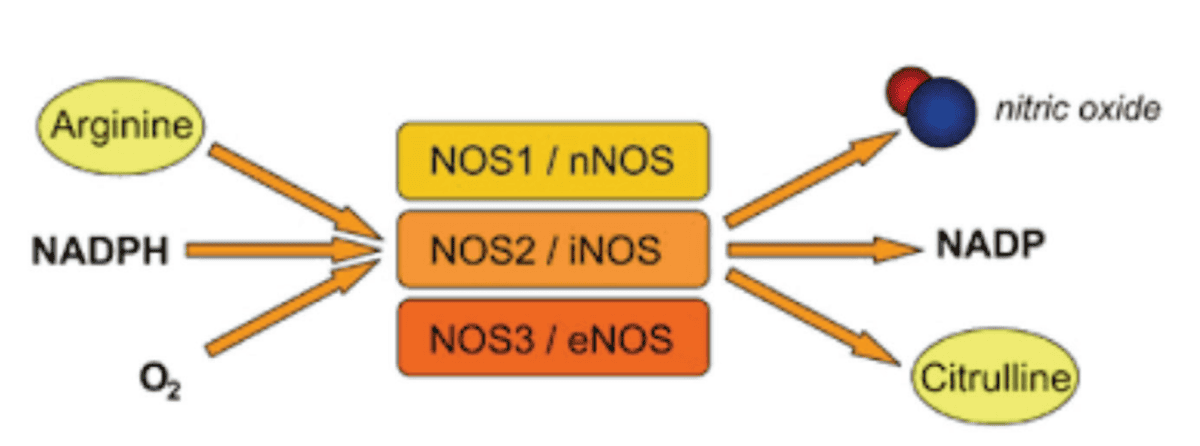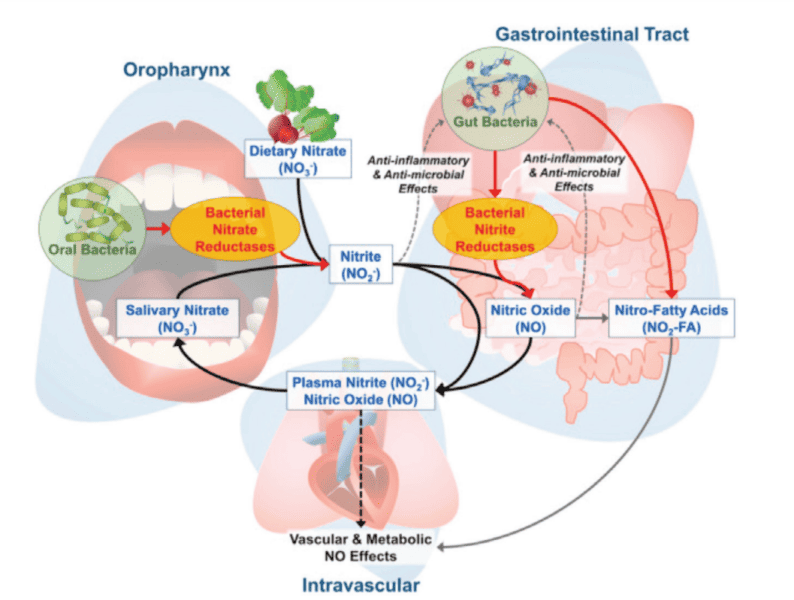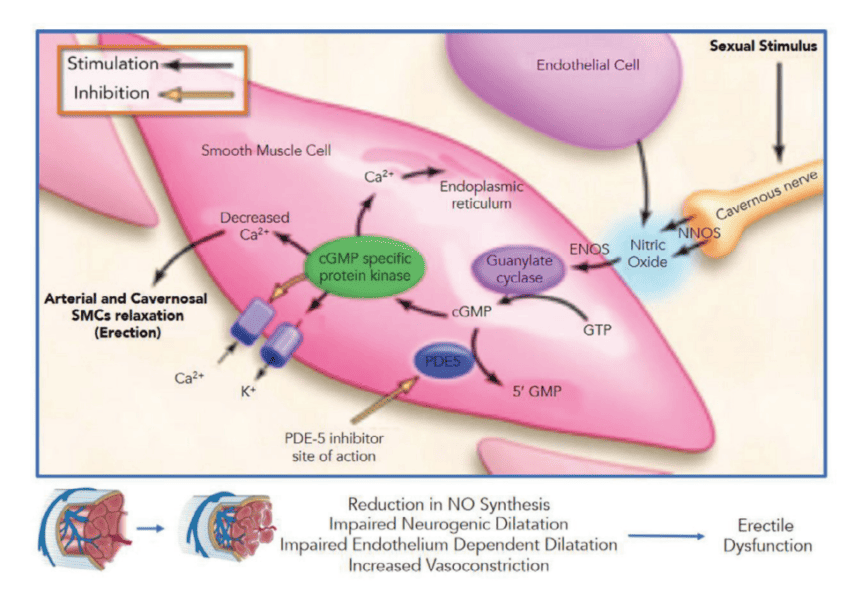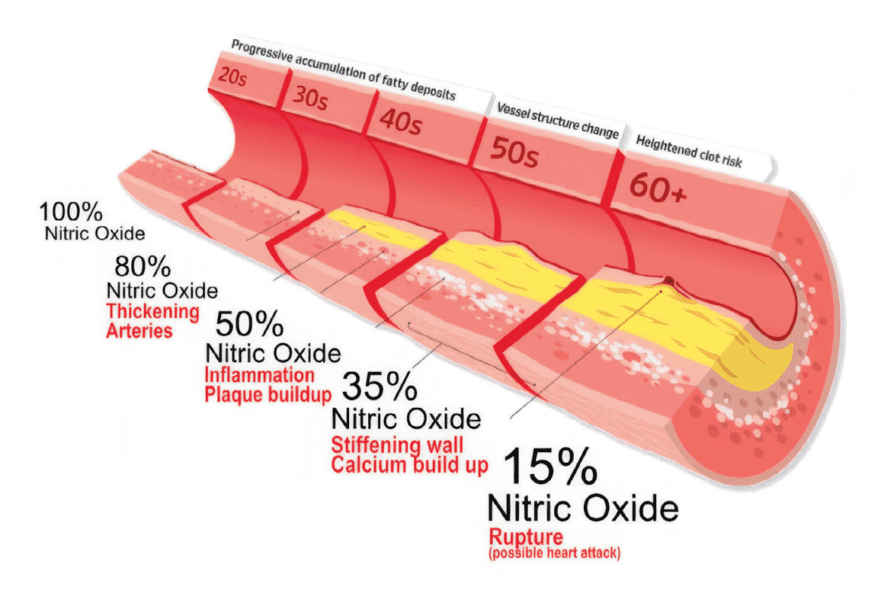Dr. Steve Lamberg offers information on nitric oxide, a messenger molecule that can affect total health and sleep-breathing disorders.
 by Dr. Steve Lamberg
by Dr. Steve Lamberg
If you’re not already jazzed up by nitric oxide “NO”, buckle up for a deep dive into this multifarious messenger molecule that impacts vascular and metabolic functions. Learn how NO, SRBD and dentistry are inseparable. Gain an understanding of intrinsic and extrinsic factors influencing pathways of both NO production and inhibition, along with issues of bioavailability and health consequences. NO is at the crossroads of dentistry, airway, and total health, and this is where our journey begins.
There are two distinct pathways that produce NO in eukaryotic cells. One is an oxidative pathway which uses L-arginine as a substrate and produces NO and citrulline while the other is a reductive pathway to produce NO from nitrate and nitrite as substrates, all of which exhibit enhanced vasoactive signaling in hypoxia and stress.
The oxidative pathway, also referred to as the endogenous pathway, uses nitric oxide synthase “NOS” to convert L-arginine to NO and citrulline. NOS has three isoforms which have been identified as follows: neuronal NOS (nNOS or NOS 1), inducible NOS (iNOS or NOS 2), and endothelial NOS (eNOS or NOS3). See Figure 1.

eNOS is primarily involved in the regulation of vascular tone, inhibition of platelet aggregation, and atherosclerosis prevention and is produced by vascular endothelial cells. iNOS is rapidly upregulated in inflammatory and infectious conditions and is thought to be involved in septic shock and immune defense against: bacteria, viruses and other microbes. iNOS also helps in synaptic transmission including getting information from peripheral nerves to the brain. nNOS is most noted for production in neuronal tissue where its functions include synaptic plasticity, blood pressure regulation and pain perception.
The reductive pathway involves oral microbial communities which supplements endogenous NO production by reducing dietary nitrate to nitrite. This exogenous “enterosalivary” pathway starts in the mouth where oral bacterial reductases convert dietary nitrate to nitrite as a substrate.2 Some nitrite is further reduced to NO in the acid environment of the stomach and intestines. Nitrate and nitrite are absorbed in the intestines and into the blood. Excess nitrate (about 75%) is excreted by the kidneys. While Nitrite “NO2” in the blood is reduced to NO or oxidized to nitrate “NO3”, NO is oxidized to nitrite and nitrate. Finally, active uptake of nitrate from the blood then occurs in the salivary glands. See Figure 2.

Cardiovascular disease “CVD” is arguably the most significant consequence that connects NO and SRBD. NO protects against the onset and progression of CVD.2,3,4 Not only does hypoxia from SRBD decrease the oxygen necessary to make NO, but SRBD could also be described as the intermittent failure to transport the full complement of nasal NO to the lung with each breath. The nasal NO is mainly produced in the paranasal sinuses using iNOS.5,6 Interruption of NO supply to the tissues as well as lack of oxygen eventually leads to hypertension, myocardial infarction and stroke. Arguably the most important NO role is in vasodilation which is initiated by the stimulation of soluble guanylate cyclase, leading to increased production of cyclic guanosine monophosphate (GMP) from GTP that is dephosphorylated, which in turn activates GMP-dependent kinases to decrease intracellular calcium concentrations. This leads to relaxation of the smooth muscle cells in the media of the endothelium. Other roles of NO include the following: anti-thrombotic, anti-smooth muscle proliferation, anti-inflammatory, reduces release of and scavenges superoxide radicals, reduces oxidation of LDL cholesterol, reduces monocyte stickiness and adhesion which helps prevents plaque formation reducing risk of heart attack and stroke. And of course, it activates relaxation of corporal cavernosal smooth muscle tissue increasing blood flow in the penis resulting in an erection. See Figure 3.

Another prisoner of SRBD that relates to NO is dementia. It can be caused when SWS is decreased leading to decreased glymphatics which results in buildup of plaque in the glial cells. Dementia can also be caused by blood flow problems which is called vascular dementia “VaD”.7 VaD is the second most common dementia which occurs when eNOS is inactivated and leads to cerebral vascular endothelial dysfunction, while nNOS is overactive and can produce excessive NO resulting in neurotoxicity.
“NO is more relevant to the health span than you’ve ever imagined.”
NO also plays a role in pulmonary arterial hypertension “PAH”. PAH with subsequent right ventricular failure can lead to death. Administration of nitric oxide by inhalation acutely improves hypoxemia associated with pulmonary hypertension in humans and animals. This is due to its ability to increase levels of cyclic GMP and induce pulmonary vasodilation. Drugs for treatment include phosphodiesterase-5 (PD-5) inhibitors which have been approved to control pulmonary vascular tone.
The exogenous enterosalivary pathway of reducing dietary nitrates, found in leafy green vegetables, to nitrite in the mouth has some interesting connections with dentistry. The final reduction of nitrite to NO happens in the acidic environment of the stomach and intestines. This “enterosalivary” pathway is dependent on oral bacteria to produce the requisite reductase enzymes.2 The oral microbiome consists of commensal and pathogenic bacteria, both of which can produce reductases. Mouthwashes prescribed to reduce pathogenic bacteria may inhibit all bacteria which would decrease the production of reductases and greatly reduce this pathway for NO production. As it turns out, the pathogenic bacteria are more sensitive to higher pH rinses whereas the commensal bacteria are less affected by the higher pH mouthwashes. Due to this differential in pH impact on the oral biome it is recommended to use a high pH mouthwash to maintain the enterosalivary pathway for NO production while still being able to control the levels of pathogenic oral bacteria. This becomes even more important over the age of 50 when eNOS is decreased due to aging changes in the endothelium (Figure 4). Recent evidence shows that tongue cleaning does not have a negative affect on NO production.8

Can you have too much of a good thing? Although NO has an anti-inflammatory effect under normal physiological conditions, it is a pro-inflammatory mediator that induces inflammation due to over production in abnormal situations. As NO plays a role in inflammation, recent studies indicate that exhaled oral nitric oxide measurement in OSA may be used as a marker of upper airway obstructive episodes due to mechanical trauma and of hypoxemia causing local oropharyngeal inflammation. As well as being a possible risk factor of OSA, exhaled oral NO, through its ability to amplify oxidative and nitrosative stress may also have a pathogenetic role in OSA.9
NO is more relevant to the health span (the length of your lifetime that you’re healthy) than you’ve ever imagined. In addition to regulating vascular smooth muscle tone, NO directly affects mitochondrial respiration which can wreck havoc with carbohydrate metabolism. Studies show that NO plays important roles in the development of metabolic syndrome components such as: endothelial dysfunction, insulin resistance, hypertriglyceridemia and chronic adipose tissue inflammation. Decreased eNOS-derived NO bioavailability as well as iNOS-induced overproduction of NO is involved in the development of type 2 diabetes mellitus (T2DM). NO donors may improve insulin signaling and glucose homeostasis in T2DM and insulin resistance (IR), suggesting the potential clinical importance of NO-based interventions.10
Inhibitors of NO include many factors such as: aging, oxidative stress, lack of exercise, poor nutrition, diet high in saturated fats11, diabetes, smoking, salt, non-basic pH mouthwash, high levels of ADMA12, SRBD, medications that reduce acid production in the stomach such as PPIs. Research shows being on PPIs for 3 years increased the rate of heart attack and stroke by 35%.
Upregulators of NO include the following: nasal breathing, eating vegetables high in nitrates (celery, garlic, cress, chervil, lettuce beetroot, spinach, arugula), and other foods that support NOS bioavailability (meat and seafood that contain CoQ10, dark chocolate, citrus fruits, pomegranate, nuts and seeds, watermelon, and don’t forget the red wine!), antioxidants (Vit C, Vit E, Polyphenols, Glutathione, Melatonin), NO boosting supplements (L-Argenine, L-Citrulline), highest pH mouthwash, 30 mins per day exercise to keep endothelial cells healthy, and having good quality sleep. If all else fails, try listening to Barry White.
The next time you hear about NO you’ll not only appreciate its role in relaxation of blood vessels but also how it correlates with SRBD and so many dental conditions. This article can help you optimize your health and the health of your patients. Hopefully learning about the roles and misbehavior of NOS enzymes and their connection to mitochondrial health will pique your curiosity to learn more about the miracle molecule NO. How we build on this science and incorporate it into a workflow in our day to day dental practice is a topic for another article but spending more time on reviewing and discussing the medical history is a good place to start.
“The saddest aspect of life right now is that science gathers knowledge faster than society gathers wisdom.” – Isaac Asimov
The role of nitric oxide is also explained in “Healthy Cells, Healthy Brain: Nose Breathing is Fundamental.” You can read it at: https://dentalsleeppractice.com/healthy-cells-healthy-brain-nose-breathing-is-fundamental/
- Kawasumi, Takeno, Ishikawa, Takahara, Taruya, Takemoto, Hamamoto, Ishino, Ueda. The Functional Diversity of Nitric Oxide Synthase Isoforms in Human Nose and Paranasal Sinuses: Contrasting Pathophysiological Aspects in Nasal Allergy and Chronic Rhinosinusitis. Int. J. Mol. Sci. 2021, 22,7561.
- Charlene E. Goh , BDS, DrPH; Bruno Bohn , MPH; Clarisse Marotz , PhD; Rebecca Molinsky , MPH; Sumith Roy , MBBS, MPH; Bruce J. Paster, PhD; Ching-Yuan Chen, PhD; Michael Rosenbaum, MD; Melana Yuzefpolskaya , Nitrite Generating and Depleting Capacity of the Oral Microbiome and Cardiometabolic Risk: Results from ORIGINS , J Am Heart Assoc. 2022
- Jinqiang Zhu, Wanshan Song, Lin Li and Xiang Fan, Abstract Endothelial nitric oxide synthase: A potential therapeutic target for cerebrovascular diseases, Molecular Brain (2016) 9:30
- He M, Wang D, Xu Y, Jiang F, Zheng J, Feng Y, Cao J, Zhou X. Nitric Oxide-Releasing Platforms for Treating Cardiovascular Disease. Pharmaceutics. 2022 Jun 25;14(7):1345.
- JON O. LUNDBERG, Nitric Oxide and the Paranasal Sinuses, THE ANATOMICAL RECORD 291:1479–1484 (2008)
- Remon Bazak, Samy Elwany, Amir Mina and Mostafa Donia, Nitric oxide unravels the enigmatic function of the paranasal sinuses: a review of literature, The Egyptian Journal of Otolaryngology (2020) 36:8
- Zhu, Hong, Yang, The Roles of Nitric Oxide Synthase/Nitric Oxide Pathway in the Pathology of Vascular Dementia and Related Therapeutic Approaches. Int. J. Mol. Sci. 2021, 22, 4540.
- Tribble GD, Angelov N, Weltman R, Wang B-Y, Eswaran SV, Gay IC, Parthasarathy K, Dao D-HV, Richardson KN, Ismail NM, Sharina IG, Hyde ER, Ajami NJ, Petrosino JF and Bryan NS (2019) Frequency of Tongue Cleaning Impacts the Human Tongue Microbiome Composition and Enterosalivary Circulation of Nitrate. Front. Cell. Infect. Microbiol. 9:39. doi: 10.3389/fcimb.2019
- Feng X, Guo X, Lin J, Zhao Z, Tong Z. Risk factors and fraction of exhaled nitric oxide in obstructive sleep apnea in adults. J Int Med Research. 2020 Jul;48(7)
- Bahadoran, Mirmiran, Ghasemi,Role of Nitric Oxide in Insulin Secretion and Glucose Metabolism,Trends in Endocrinology an dmetabolism, REVIEW VOLUME 31, ISSUE 2, P118-130, FEBRUARY 2020
- Yvette C. Luiking, PhD, Mariëlle P.K.J. Engelen, PhD, and Nicolaas E.P. Deutz, MD, PhD, REGULATION OF NITRIC OXIDE PRODUCTION IN HEALTH AND DISEASE, Curr Opin Clin Nutr Metab Care. 2010 January ; 13(1): 97–104.
- Mohammad Badran, Saeid Golbidi, Najib Ayas, and Ismail LaherNitric Oxide Bioavailability in Obstructive Sleep Apnea: Interplay of Asymmetric Dimethylarginine and Free Radicals Review Article, Sleep Disorders, Volume 2015, Article ID 387801

 Dr. Steve Lamberg has been practicing comprehensive restorative dentistry in Northport, NY for 40 years. Always passionate about sleep and wellness, he became a Diplomate of the American Board of Dental Sleep Medicine in 2011 and has served on their board review faculty. He holds several patents, and is the inventor of the Lamberg SleepWell Appliance, which is FDA-cleared for the treatment of OSA. Dr. Lamberg also launched and serves as the director of the Pediatric and Adult Airway Network of New York (PAANNY), to provide a local platform where dentists, physicians, orofacial myologists, and other related professionals learn and collaborate on treatment patients of all ages. Additionally, Dr. Lamberg serves as a Scientific Advisor at the Kois Center in Seattle. His recently published book for the general public, “Treat the Cause…Treat the Airway” correlates many common medical conditions to airway and sleep and is available on Amazon.
Dr. Steve Lamberg has been practicing comprehensive restorative dentistry in Northport, NY for 40 years. Always passionate about sleep and wellness, he became a Diplomate of the American Board of Dental Sleep Medicine in 2011 and has served on their board review faculty. He holds several patents, and is the inventor of the Lamberg SleepWell Appliance, which is FDA-cleared for the treatment of OSA. Dr. Lamberg also launched and serves as the director of the Pediatric and Adult Airway Network of New York (PAANNY), to provide a local platform where dentists, physicians, orofacial myologists, and other related professionals learn and collaborate on treatment patients of all ages. Additionally, Dr. Lamberg serves as a Scientific Advisor at the Kois Center in Seattle. His recently published book for the general public, “Treat the Cause…Treat the Airway” correlates many common medical conditions to airway and sleep and is available on Amazon.